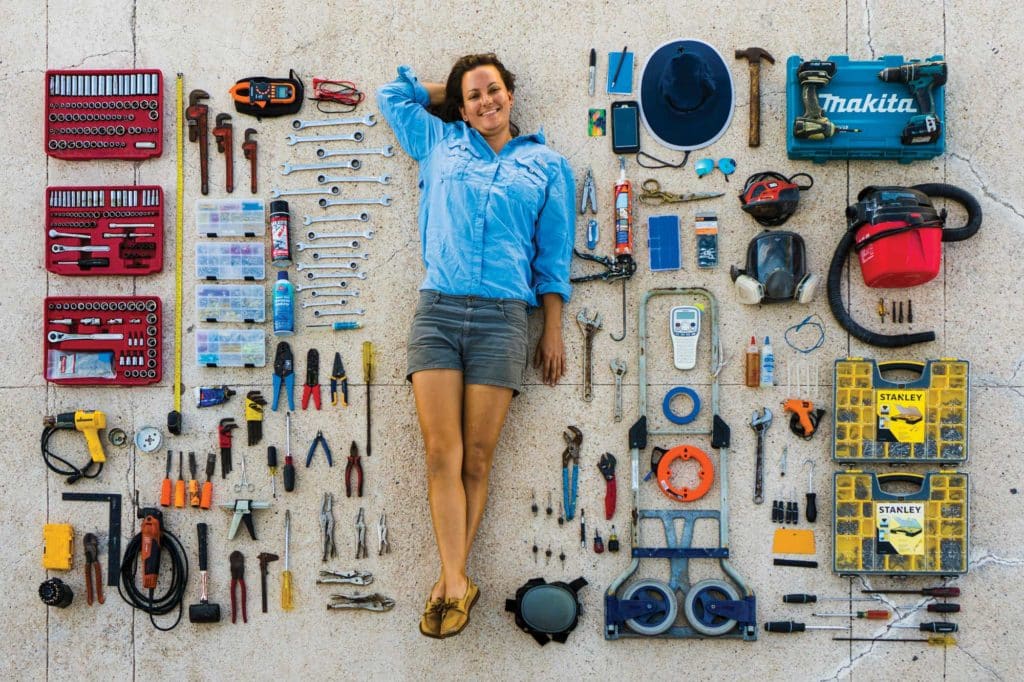
I grew up watching my dad and grandpa use these tools,” Casey said, as he unpacked. “It was always my favorite place to be: in the shop, at their side. Even when I could hardly see over the workbench.” I was 19, working as a liveaboard deckhand on a schooner, and Casey had just arrived as the new captain. He had recently inherited those tools and had them shipped to him, cross-country, in a series of flat-rate boxes. Even though it was more than he would likely need in his new position, having them close by made him feel prepared for anything. I still remember looking over that collection of wrenches, sockets, pliers and hammers. Tools that generations had lovingly oiled, their carved initials darkened into the worn handles.
Tools are personal. For sailors, they are at our side, hour after hour, day after day, as we go about re-forming a tiny piece of the world into the shape of our dreams. They are in our hands in our most desperate moments, when emergency strikes and hearts skip a beat. They are in our stories, when we tell of our challenges, triumphs and adventures. Seeing an old tool can spark miles of memories, and transport us back to a time, a place or people long left behind. Peer closely into a tool bag and you can see a whole life story: where we’ve been (those stubby metric wrenches from my first motorcycle kit); who we are (the fiberglassing scissors for boatbuilding projects); and where our dreams and fears lie (the giant bolt cutters that I bought in anticipation of crossing oceans).
I can perfectly remember my first set of tools. It had initials carved into the handles too: I-K-E-A. It was one of those $7 orange tool kits the Swedish store sells: hammer, crescent wrench, pliers, screwdriver and Allen key (of course). My mom bought it for me, and it still makes me feel lucky to have the kind of mom who, when helping her daughter get ready for her first semester at college, threw a toolkit in the cart alongside the throw pillows, flat-packed birch desk and tea candles. Maybe even back then she sensed that her suburban, soft-palmed daughter would veer off into the world of docks, boats and calluses. Or maybe the toolkit itself was to blame, its “Fixa” name revealing its ambitions toward me all along.
I have never known boats without tools; the two appeared and remain side by side in my life. Maybe this means I’ve been hanging out with and loving the wrong kinds of boats. But some of this is inherent to the pursuit itself. On boats, we use tools more often—and often more desperately—than onshore. In our small boat spaces, we literally live among our tools, emptying precious lockers to accommodate them, sleeping with them directly under our bunks. We become brothers in arms with our tools. As we cruise—jumping between anchorages, bouncing between boat projects—we bleed, repair, patch and improvise…together. We sailors collect sunburns, our tools collect rust, and the sea stories pile up.
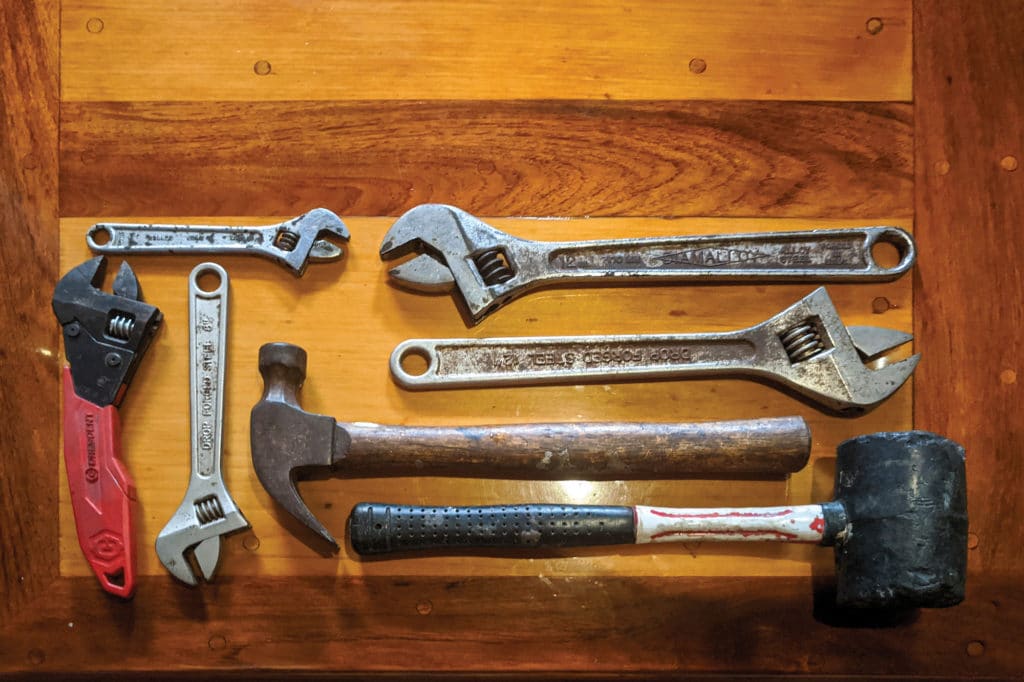
My first little orange toolkit was the start of a story, and parts of it survived well into my evolution as a boatwright. Pulling out Ikea tools wasn’t exactly helping to clear the path of skeptics: Already I was showing up to new jobs decades younger and much more female than most expected. I remember a female client warning me jokingly about my Ikea-size Ikea hammer: “You should get a real hammer. No one is going to take you seriously with that little toy!” But I had a soft spot for my little Swedish half-soldier and stayed loyal to it up until its very end. Maybe it was just my stubbornness, or maybe it was camaraderie with something else that was a bit unexpected in its surroundings. The hammer finally met a predictable demise when its little head was torqued from its plastic handle by my boss at the boatyard. I had offered it up to him, and this large hulk of a man, his glimmering blue eyes happily focused on the challenge at hand, hardly noticed the death of my companion as he tossed it aside and muttered about needing “something bigger.”
Check out more: Sailing Gear
Through the years, many tools have passed through my hands, and the orange snap case has long since given way to a tool bag of more-conventional proportions and coloring. My toolkit today reflects my continuing work as a traveling boatwright, and also as a cruising sailor. After years of service in a marine environment, my tools look far removed from the Father’s Day and Black Friday displays I picked them from. Which is fine. From all that I’ve seen, the best toolkits are hardly ever shiny. Like fur worn off a Velveteen Rabbit, well-used tools look rough in all the right ways. They become real when you’ve spent enough time with them.
My tools have seen boats at their best and worst. They’ve been loaded into dinghies and lifted up ladders. They have crossed borders and made passages, been rained on, dropped, lost, and covered in strange substances. They have competed in competitions and made miracles happen after midnight. Running through a mental list of them feels like remembering the names of old friends. Let me introduce you to some of my favorites.
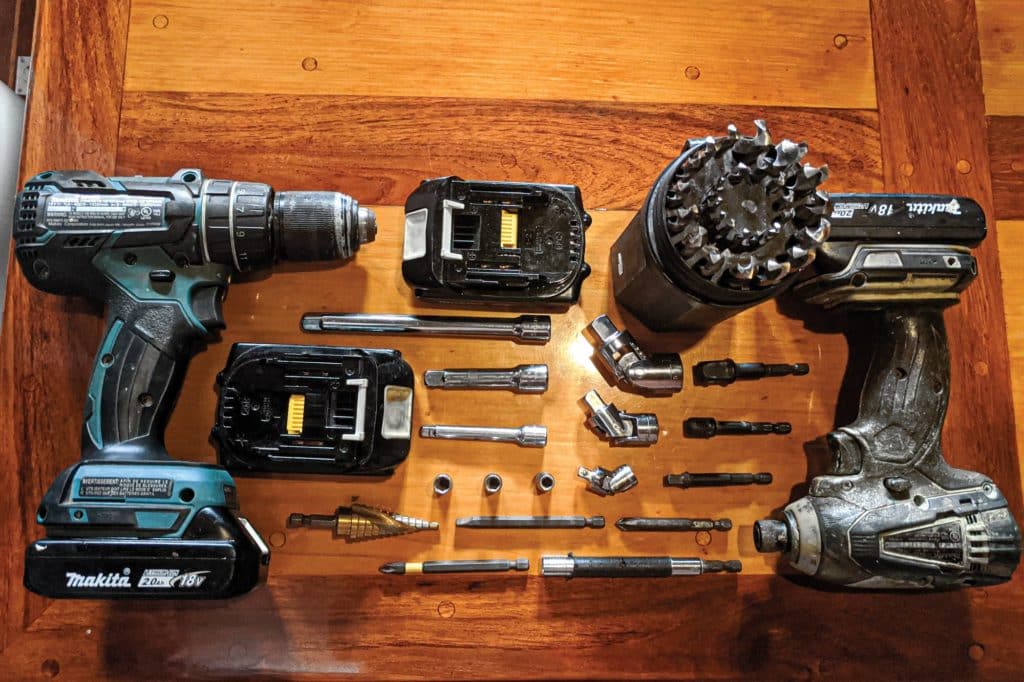
Drill and driver with lithium rechargeable batteries: The drill is pretty straightforward, but let’s talk about the driver. I don’t see these in many boat toolkits, but it is one of my top-used tools. With a screw bit, the driver zips screws in and out at lightning speed. If tightness needs to be precise, I’ll finish up with a screwdriver, where I can better feel the torque being applied.
Snap a socket-bit adapter into the driver, and you get even more functionality. Removing nuts or bolts with this setup is not only much faster than using a wrench, but it also can fit in places where a wrench doesn’t have swing room, or where swinging a wrench would involve a lot of knuckle bloodying. Importantly, it also helps in those times when you can just barely reach a fastener, maybe only with your fingertips, but not in a way that makes you able to apply any strength to it. Pass the driver through to this spot, maybe even using an extension or jointed extension, and often all the strength you need is to push a button. Hose-clamp removal and installation is also super-fast with a small socket on the end, although be careful not to overtighten and damage the hose.
This setup also can help in removing stubborn fasteners by pulsing the driver at short intervals to break free corrosion bonds. I also use it as the first thing to try for one-person, through-deck hardware removal. Often I can zip off nuts from belowdecks while the sealant bond still keeps the bolt or screw from moving, or with a Vise-Grip clamped on the bolt from above if the nut is really stuck.
Mechanical calipers: I have digital ones too, but they are delicate and are stored in a case, not in my tool bag, and I don’t use them too often. Most of the measuring I do is to confirm hose or thread sizes, and measure thread depths and material thicknesses or shaft sizes. I’m typically not looking for thousandths-of-an-inch accuracy, and so this little guy is perfect. It is durable enough to live in my bag, and it never needs batteries. Apparently, it does need a cleaning though.
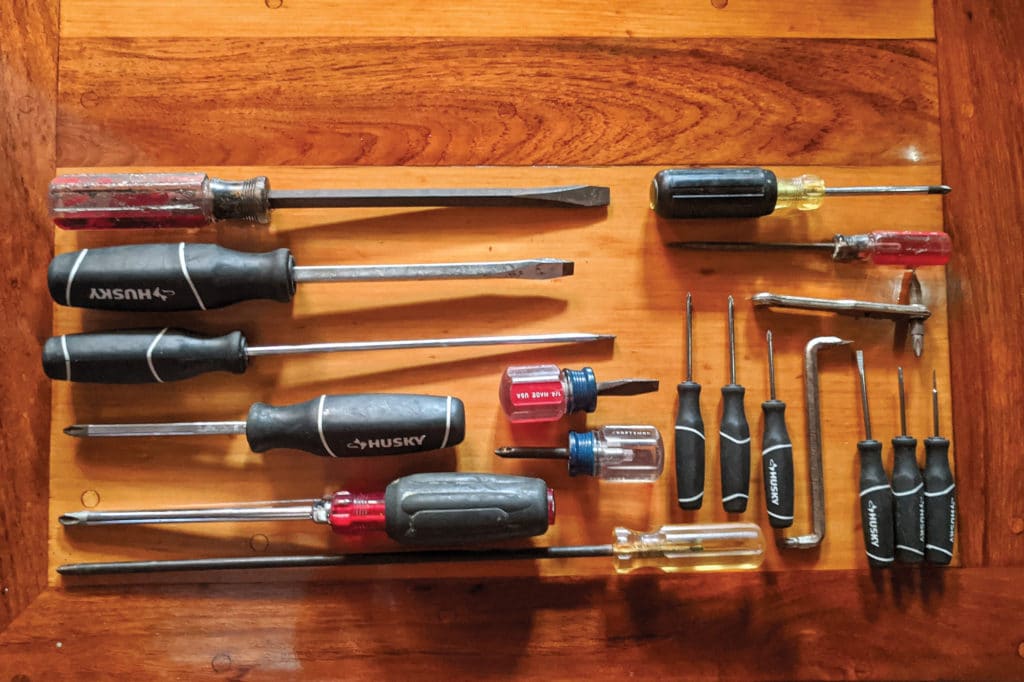
Oscillating multitool: The oscillating multitool sees a lot of use. It fits in all sorts of spaces because you can rotate the blade relative to the body. Because it just vibrates, it’s also very safe and easy to use, a definite plus when working in remote anchorages where a catch or lurch from a circular saw or reciprocating saw can have added risk. It’s easy to make cuts in delicate or small areas (such as where there are hoses or wires nearby) because you have so much control.
This tool is also my preferred way to cut round things, including plastic through-hulls that I need to trim down, or any hoses that are too big for my cable cutters, such as sanitation or exhaust hoses. Cuts come out straight, clean and fast. If the hose has reinforcing wire, I cut that with cable cutters after.
I also use this to make very clean and controlled cuts for finish work, such as when you’re cutting into teak down below to install a new panel or gauge or to add a trim piece. You can also easily make blind cuts, like if you need to create a small recess for a hinge or panel frame to sit flush. By marking and scoring a line, or by clamping down a straightedge, you can make long, straight cuts. With a variety of blades available, you can cut through all sorts of material. I’ve cut through fiberglass, copper, bronze, aluminum, wood, plastic and rubber.
Label-maker: This is a nice organizational tool to have on board. I label everything. I like to tag electrical wires at their origin and termination points with a little label flag, saying what it’s for, where it runs to, if there’s a fuse or connection in-line, and any other useful notes about it that I might not remember in a few years when I next look at it. I hate having to work out what a toggle switch, seacock, valve, strainer and so on is for, so I label them. I sometimes label hoses, which is especially handy for complicated fuel-polishing or -transfer systems. Since labels don’t stick to hoses very well, I slip clear shrink-wrap over them.
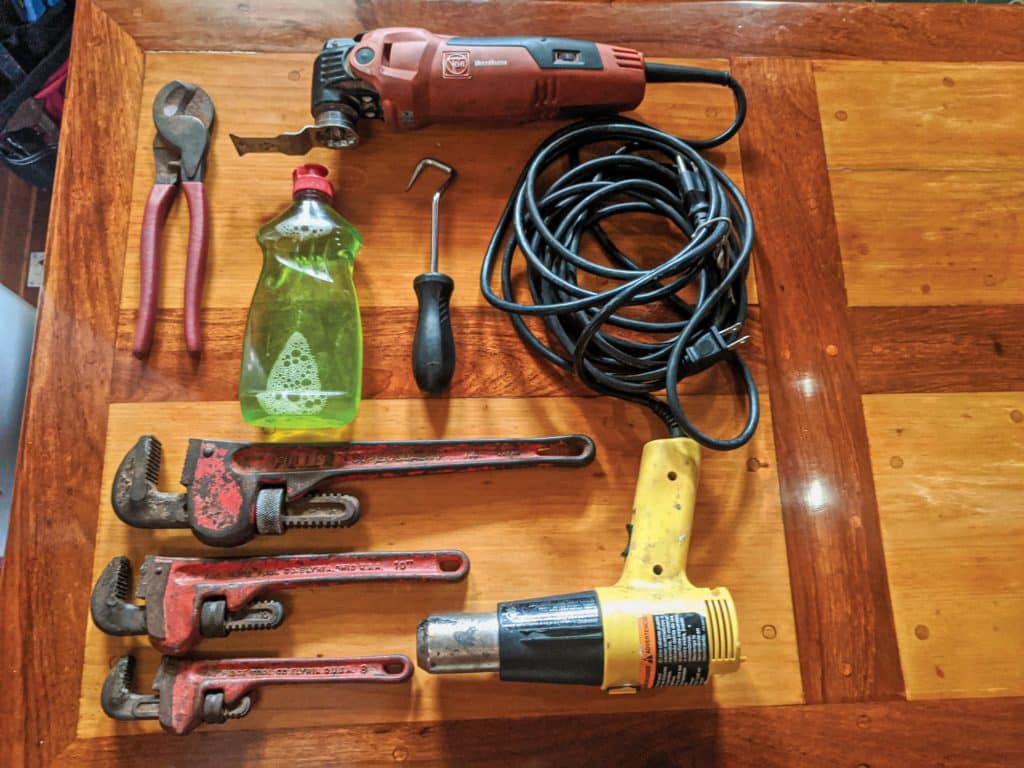
Hose puller: For stubborn hoses, this is a great additional tool. For a hose I can’t get off by hand, my first step is normally to try to get it to twist using a pipe wrench. Once I have it twisted, if it still won’t come off, I’ll slip the hose puller under one side and then try to work off the hose. Be aware that the hose puller does have a sharp end, which can dig into the side of the hose. This is no problem if the hose you are removing is getting replaced, but this isn’t good if you are planning on reusing the hose and there isn’t enough play in the run to cut off a few damaged inches.
The old straightened wire hanger: Simple, but when you need it, it’s a godsend. For short runs of wires or hoses through blind areas, lead the wire through first. Tape off the leading edge so it doesn’t damage or snag.
Black stir sticks: I always have a few in my bag. They are great for applying glues and sealants, removing sealant around newly bedded hardware, mixing and applying epoxies and adhesives, wrapping sandpaper around to sand into flat sides, cleaning off old sealant from surfaces you don’t want to scratch (wrap the stir stick in a small rag dipped in thinner), and for using as protection for nice finishes if you have to pry off something. Bang in the plastic stir stick first, then bang in your metal spreader between the stir stick and the piece you’re removing.
Rubber strap wrench: This is great for removing all kinds of filters and housings, things that are irregularly shaped, that are bigger than any wrenches or channel locks you have aboard, or that you don’t want scratched. On our boat, we have different filter wrenches for oil filters, fuel filters, watermaker pre-filters and freshwater carbon filters. When I don’t want to pull out those (or as a backup if we lose one), I use the strap wrench. I also use it to remove our older-style Racor filters, and to remove our wheel because it is held on by a nicely polished tapered nut that anything else would scratch. The strap wrench definitely has its limits for how much torque you can apply with it—it is rubber and plastic—but I love having it as an option.
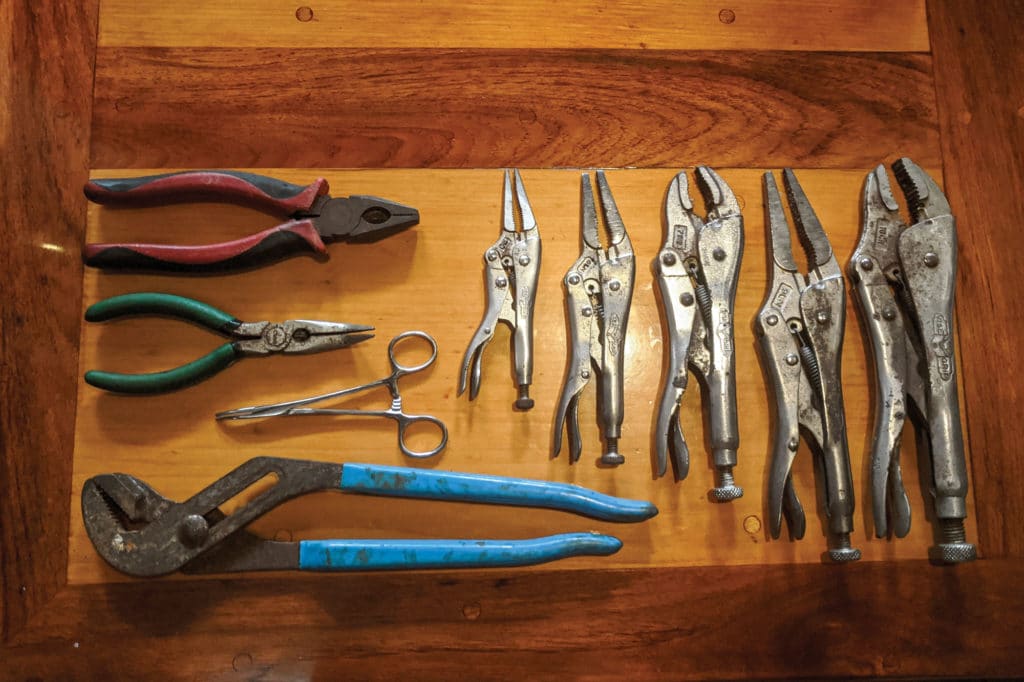
Screwdrivers: I’m currently missing a few—ones borrowed and not yet returned. Be mindful of using the right size because using the wrong size makes stripping the head much more likely. Also, if your Phillips fastener head is starting to strip, you can sometimes save it by moving up a size. I prefer screwdrivers with square shanks or somewhere I can attach a big crescent wrench. For very stuck fasteners, such as ones you often find on masts or on winches, I lean my entire body weight onto the screwdriver and then turn the crescent wrench (or for very, very stuck fasteners, have another person turn the crescent wrench). I also have a tiny screwdriver set, which I increasingly use for small electronics stuff. And I carry a few stubby screwdrivers, as well as ratcheting and fixed-right-angle screwdrivers.
Wire strippers, ratcheting crimpers, regular crimpers, small snips: Increasingly there are a lot of little wiring and electrical jobs on boats, and having the right tools makes it easy to do a great job and not have to revisit things later. I carry ratcheting crimpers as well as nonratcheting ones because, while the ratcheting tools do a nicer job, they don’t always fit into tight spaces. The small snips are crucial for cutting away jackets in bundled wires without any damage. In addition to the normal selection of 10-12 yellow, 14-16 blue, and 18-22 pink AWG connectors you commonly see on marine-store shelves, I also carry 22-26 yellow AWG connectors that I often use with small new electronics wiring tasks, like making up data cables, or adding small in-line fuses or regulators.
Cellphone: I use my phone to make part lists and write notes, to take pictures of things before I take them apart, to keep track of time, and occasionally as a flashlight if I don’t have my headlamp. I also take photos of places where I can’t get my eyes; it’s also invaluable for that model number written on the backside of the pump, or for things too far away to see (zooming in on a picture has saved me a trip up the rig before). Mine is in a waterproof case because things happen.
These are some of the tools I carry; there are many more that I didn’t have space for here. While my entire collection is probably more extensive than most due to my work fixing boats, nothing is terribly exotic. It typically doesn’t need to be. Whether working on a hydraulic dinghy hoist on an 80-foot luxury motoryacht, a hatch installation on a 14-foot rowboat, or a systems overhaul on a cruising sailboat, the basic tools I use are largely the same.
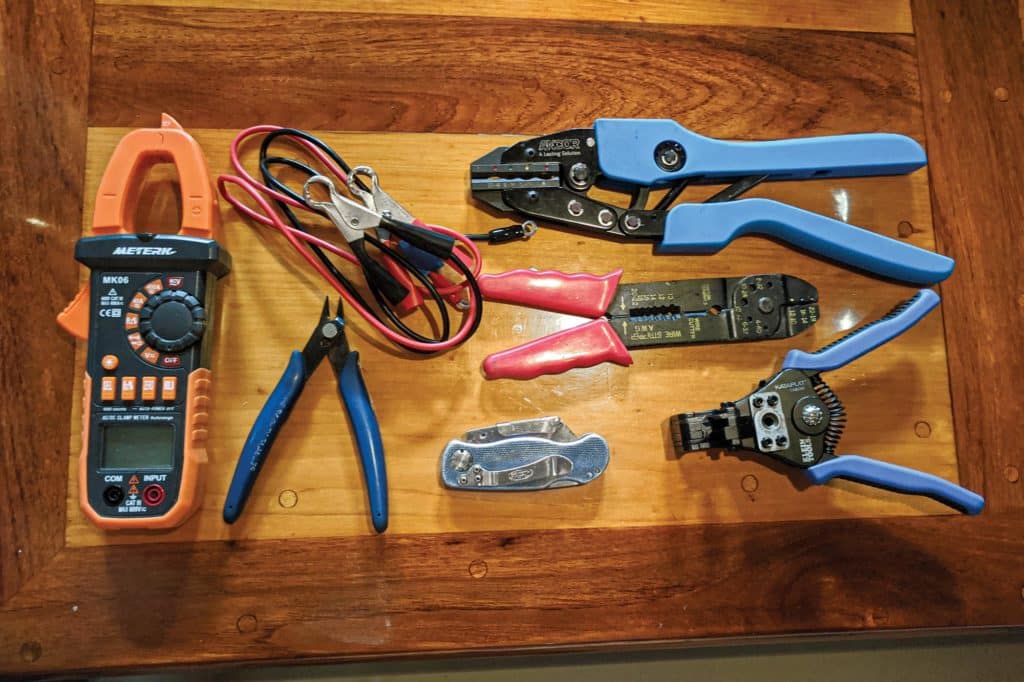
Assembling a great boat toolkit doesn’t happen in stores. It happens in the engine room, on the foredeck, at the top of the rig. Looking to assemble a new kit? My advice: Buy a bag and start a project aboard. Change the oil, rebed a cleat, service a winch. Pay attention to the tools you’ve used and pack them in, taking note of which ones can be used at anchor versus ones that require you to be at a dock. Look at your critical systems and run through common problems you might encounter. Do you have wrenches big enough to adjust your packing-gland nut? Do you have the deep socket you’ll need for that bleed valve? Remember that once you’re on the water, there are really only two types of tools: those that are on board, and all those wonderfully handy, theoretical ones that aren’t.
Tools are like any instrument: They need practiced hands to make them really sing. The more you engage, the more powerful and effective you and your toolkit will become. There will be challenges: a corroded head that snaps or a rookie mistake that you swear you won’t make again (and again). But your hands will get smarter, your patience will grow longer, and today’s calamities will turn into next week’s sundowner stories. Before you know it, that new empty bag will look perfectly full, and rough in all the right ways.
Who can predict what unique toolkit you’ll eventually create, and what stories it will have to tell? You never know—it might even be the beginnings of a new family heirloom. A collection your daughter will one day lovingly unpack in front of her new crew, looking on as their new captain reveals…what’s in her bag.
Marga Pretorius is a traveling shipwright and cruising sailor. She lives aboard her 1977 Kelly Peterson 44, Dogfish, and is currently based in Mexico. For more on her work and travels, visit her website.








